3.3 Major Scientific Discoveries in Medicine and Drug Therapies
The varied uses of medications arose out of scientific discoveries in the related fields of medicine and pharmacy. This section highlights landmark discoveries that have had an outstanding impact and lasting effects on drug use, development, and the practice of pharmacists and technicians.
Drugs from the Science of Germ Theory
Contagious disease outbreaks and deaths from certain types of contaminated medications are the result of microorganisms, and contemporary prevention practices are based on the science of germ theory. In the late 1700s, scientists were just beginning to understand the existence of microorganisms (microbes)—microscopic or one-celled organisms—and their role in causing illness. These microbes include bacteria, viruses, fungi (including mold species), and protozoa, which will be discussed in greater detail in Chapter 12. An understanding of the role of microbes in causing illness developed into the germ theory of disease. Groundbreaking discoveries in germ theory led the way to vaccines, antibiotics, and the aseptic (germ-free) techniques used today.
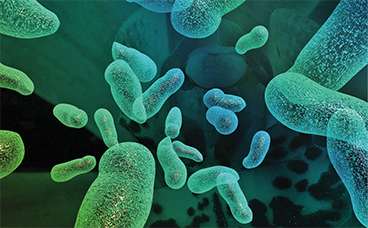
This computerized image shows microscopic bacteria.
Smallpox—The First Vaccination
A major cause of premature deaths globally in the 1700s, much as heart disease and cancer are today, was a disease called smallpox. It was caused by various strains of the smallpox virus. Those lucky enough to survive were left scarred with pox marks over their faces and limbs, and were often made blind. No one knew how to prevent or cure smallpox. When explorers and armies from Europe brought it with them to the Americas, the disease decimated the Native American nations who lived here.
 Put Down Roots
Put Down Roots
The words antibody, antibiotics, and antigen all come from the Greek prefix antí, meaning “against.”
Dr. Edward Jenner observed that dairy workers previously exposed to cows with cowpox didn’t get smallpox. Jenner theorized that cowpox exposure triggered people’s bodies to provide special protection, or immunity, to the smallpox virus. So in 1796, Jenner tried introducing a tiny portion of matter from a cowpox lesion under the skin of a healthy individual and discovered that person did not contract smallpox later—despite being exposed. Jenner called the inoculation procedure a vaccination, from the Latin word vaccinus, meaning “from cows,” leading to the term vaccine.
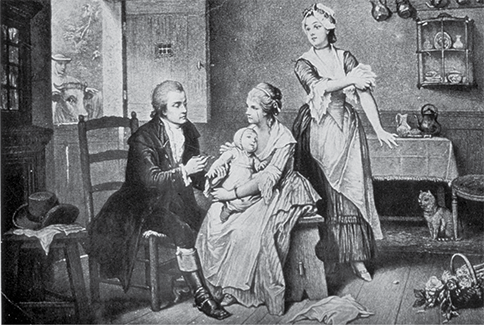
This etching, Vaccinating the Baby, by Ed Hamman, shows a traveling doctor giving a smallpox vaccination to an infant.
Vaccines work by introducing specific disease-causing dead or weakened live microorganisms or their toxins into the body. These antigen, or foreign substances, naturally cause the body to fight back, creating antibodies that can then neutralize the disease and foreign toxins. Jenner’s smallpox vaccine was refined and proved so successful that it was developed into one of the world’s first public health vaccines. The reason we don’t see the devastation of smallpox today is that it was the first infectious disease in history to be completely eradicated worldwide in 1979.
The Necessity of Cleanliness and Sterility
During the American Civil War (1861–1865), more soldiers died than in any other US war (and more died than in many wars combined). About one-fourth of the soldiers on each side died, and many more were injured and had amputations. Microorganisms killed far more soldiers than weapons—for every three soldiers killed in battle, five died of disease. With 620,000 soldiers killed from both sides (360,000 Union soldiers and 260,000 Confederate), it is estimated that more than one-fourth who died did it right in camp, from starvation, overcrowding, spoiled food, exposure, contaminated water, and insect bites. Consider that in the Union army alone, it is estimated that nearly 45,000 Union soldiers lost their lives due to diarrhea, chicken pox, mumps, tuberculosis, yellow fever, measles, and malaria, which alone claimed over 10,000 Union soldiers.

Surgical tools during the Civil War were reused over and over on different patients. Surgeons were even known to wipe off their knives and saws on their boots.
 IN THE REAL WORLD
IN THE REAL WORLD
Life expectancy for both men and women in the United States in 1900 was in the low 40s. It was even shorter in earlier years, in part due to infectious diseases. Contemporary childhood vaccines now protect against many of these once deadly infectious diseases, such as measles, mumps, rubella, chicken pox, pneumonia, hepatitis, diphtheria, tetanus, and pertussis. Life expectancies are presently nearly double: The United States averages 79 years; Canada, 82 years; and China, 76 years.
As more prophylactic vaccines are developed, however, questions arise about the administration of multiple vaccines at one time, the best timing and ages for administration (especially with infants), interactions with other drug therapies or individual body chemistries, and testing processes. Studies are ongoing to determine best practices and any potential side effects. The Centers for Disease Control and Prevention (CDC) collects data on vaccine reactions through the Vaccine Adverse Event Reporting System (VAERS), which will be further described in Chapter 14.
 Safety Alert
Safety Alert
It is important for pharmacy technicians to be up-to-date on their own vaccinations and to reassure patients that the benefits of vaccine protection outweigh the small risk of adverse reactions (such as injection site redness and soreness).
In addition, army field surgeons did not know that they should wash their hands before surgery, and they commonly did multiple limb amputations with the same cutting instruments. They also thought that pus was good medicine, and transferred it from one patient to the next. Complications from tetanus, gangrene, blood poisoning (or sepsis), and many other forms of bacterial infection often killed those who had survived battle.
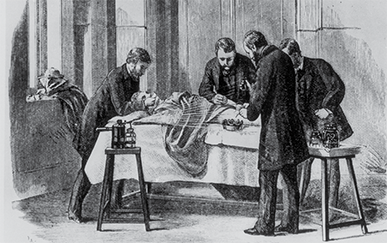
Lister used a mist of carbolic acid, the predecessor of our antibiotic spray-cleaning fluids, to disinfect the operating area before surgery, affording a huge improvement to patient recovery.
During the Civil War years, a French scientist named Louis Pasteur proved that diseases can be caused by germs, or microorganisms. He experimented with heating milk to the point where the germs were killed and then keeping it cold so that no additional germs could multiply. This process of “pasteurization” and then chilling transformed food safety, and it proved that germs do exist, though not in time to help most Civil War soldiers. However, by 1864, some surgeons were learning to control gangrene infections by pouring carbolic acid (very painful but effective) or iodine on the wounds, and female nurses—a rare but growing group at the time—brought cleanliness and clean bandages to the hospitals.
Joseph Lister, an English surgeon, applied Pasteur’s work to surgery and medicine. Lister knew that carbolic acid (or phenol) killed bacteria, so in 1867, he began spraying the surgical room and soaking surgical dressings in a mild carbolic acid solution to prevent infection. He also developed other antiseptic, or germ-fighting, protocols for surgery, including handwashing and gowning procedures. Lister’s sterile practices formed the basis of aseptic technique—processes to protect patients from harmful germs—which have been improved upon and are still in use in pharmacies, hospitals, operating rooms, and army field hospitals. (In addition to his surgical technique, Lister developed the antiseptic mouthwash Listerine.)
 Put Down Roots
Put Down Roots
Septic, which means “infection,” comes from the Greek word septikos, which means “rotten or characterized by putrefaction.” The Greek anti- means “against” while a- means “without” or “free of.” So, we get antiseptic, which fights against germs and infection, to achieve a condition that is aseptic, without germs.
Diseases Carried by Insects and Other Animals
Besides vaccines, sanitation, and aseptic techniques, other methods for disease prevention were needed. In 1897, Ronald Ross demonstrated that infectious diseases such as malaria were caused by microorganisms passed on by mosquitoes in tropical climates. Using mosquito netting, quinine (which inhibited the malaria microorganism), and vaccines for malaria and yellow fever became essential public health tactics for workers building the Panama Canal. These disease prevention techniques are still essential for anyone living, working, or visiting tropical areas today. Bubonic plague is carried by rodents, and Lyme disease is carried by deer ticks. Both of these diseases are treated with antibiotic drugs.
 Safety Alert
Safety Alert
Many people are allergic to penicillin. Always check a patient’s drug allergy history when receiving a prescription for penicillin or one of its derivatives. Make sure to effectively clean counting trays after contact with penicillin or its derivatives.
Antibiotic Drug Development
Antibiotic drugs are medications that kill or inhibit the growth of bacteria. German physician Robert Koch and his team were able to isolate and identify the individual bacterial microbes causing anthrax, tuberculosis, and cholera in the 1880s and 1890s. Their work led the way to the study of other microorganisms—including viruses, fungi, and protozoans—and eventually to the development of drugs that target them.
Penicillin—The First True Antibiotic
The first antibiotic drug, penicillin, was discovered by accident in 1928. After returning to his research lab at the end of a long vacation, Dr. Alexander Fleming noticed that many of his bacterial culture petri dishes were contaminated by fungus. In these dishes, bacteria had not grown around the mold. Fleming isolated an extract from the bacteria-killing Penicillium fungus genus, so he named the new mold-based drug penicillin. Penicillin saved many soldiers’ lives during World War II, and, in 1945, this antibiotic drug was mass-produced and marketed.
Penicillin and its derivatives are now the most widely used antibiotics in the world, and there are hundreds of other oral and injectable synthetic antibiotics.
 Work Wise
Work Wise
Fear and public shame have been historically attached to the disease of HIV/AIDS. Because it is a harsh diagnosis to receive, it is particularly important to be professional and courteous to patients with HIV/AIDS.
Combating Viruses: HIV/AIDS Challenges
Viruses are smaller than bacteria and have no cell structure of their own. They attach themselves to the cells of humans and other mammals to survive and multiply. You can be vaccinated against a virus, but antibiotics will not work against them, which has caused difficulties in dealing with outbreaks of viral diseases.
In the early 1980s, the emergence of a formidable virus—the human immunodeficiency virus (HIV)—was recognized when epidemiologists noted an outbreak of rare pneumonias and cancers in New York City. In 1983, HIV was independently isolated and verified by the Pasteur Institute in France and the National Cancer Institute in the United States. This virus progressively attacked the immune system and caused the development of acquired immunodeficiency syndrome, or AIDS. Transmitted through the exchange of bodily fluids during sexual contact, contaminated injection supplies used for intravenous drug use, or tainted blood transfusions, HIV quickly grew to be a worldwide issue. Intense virus-fighting medications had to be developed. Zidovudine, the first antiviral drug to treat HIV, was approved by the FDA in 1987. Further studies demonstrated that one drug alone was insufficient to fight HIV due to the rapid development of viral resistance. Since 1987, many additional oral and injectable HIV drugs that attack the virus at different stages of its replication process have been developed.
 IN THE REAL WORLD
IN THE REAL WORLD
One of the most destructive twentieth-century diseases was polio from poliovirus. Even President Franklin Delano Roosevelt was affected by the disease, which was characterized by muscle weakness and paralysis. Children often caught the virus swimming, and, if they survived, they might require braces, crutches, wheelchairs, or iron lungs (to help breathing) the remainder of their lives. In 1952, more than 21,000 cases of the most serious form of polio—paralytic polio—were reported in the United States alone, and there was no cure.
Then in 1953, the US physician Dr. Jonas Salk created an injectable vaccine from animal poliovirus cultures. Mass immunization programs for US children began in 1955. By 1957, there were only 2,500 US cases, and, by 1965, only 61. Polio was declared eradicated in all of the Americas in 1994, in the Western Pacific in 2000, in Europe in 2002, and in Southeast Asia in 2014. The countries of Afghanistan, Nigeria, and Pakistan continue to struggle. Worldwide, cases have dropped from hundreds of thousands to under 500 today, providing hope for total eradication. Today the inactivated polio vaccine is administered in four doses to children at 2 months, 4 months, and 6 to 18 months, with a booster dose at 4 to 6 years.
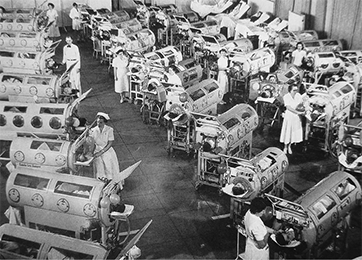
Patients who lost use of their lungs from the poliovirus had to use a ventilator, commonly called an iron lung.

The AIDS Coalition to Unleash Power (ACT UP) rallied at FDA headquarters in 1988, demanding that the FDA release investigational drugs to try to treat dying AIDS patients.
Currently, combination therapy involving three or four drugs is common. Medications given to pregnant HIV-infected patients have been shown to be effective in reducing the transmission of the virus to the newborn at delivery from 100% to 5%. HIV medications can reduce the risk of transmission after exposure.
 IN THE REAL WORLD
IN THE REAL WORLD
In the early days of the disease, a diagnosis of HIV or AIDS was virtually considered a death sentence. Today approximately 40,000 new cases of HIV/AIDS are reported each year, with more than 1.1 million people living with the disease in the United States alone. For these patients, regimented medication therapy allows many of them to lead near-normal lives.
Probiotics and Encouraging Positive Microorganisms
Not all microorganisms are bad for one’s health. In fact, contemporary science has found that many types of bacteria may be essential for good health. It has been long understood that live bacteria in yogurt, aged cheeses, and fermented foods can assist in digestive health. In 1907, Nobel Prize winner Élie Metchnikoff suggested that good digestion is dependent upon the interreactions of the bacteria in the digestive system. He believed that encouraging these positive microbes may help fight the infections of negative ones. This probiotic germ theory is one in which live microbes are used or encouraged to produce positive health benefits.
 Practice Tip
Practice Tip
It is extremely important for the pharmacist and the technician to monitor the refill frequency on HIV drugs to delay the development of viral resistance. If an irregularity in refill timing is noted, the technician should alert the pharmacist to the need for counseling.
Many health supplements have been created to encourage the right conditions for positive microbes. Physicians and pharmacists often recommend yogurt or probiotics during a course of antibiotic therapy. Community pharmacies can be particularly helpful in promoting overall health and wellness by understanding probiotics, staying up to date on the latest research, and offering reputable probiotic products for patients.
The Power of Healthy Nutrition and Vitamins
Encouraging the right conditions for organs to function well has also been found to be important. Diseases and organ malfunction can be caused by vitamin deficiencies. In the 1900s, scientists found that a lack of vitamin C caused the disease of scurvy. Scurvy causes spongy gums, loose teeth, joint pain, muscle weakness, blood loss, and eventually death. A lack of vitamin D causes rickets (bone softening and warping); and a lack of vitamin B1 causes beriberi (neuron damage, weakness, pain, and, eventually, death).
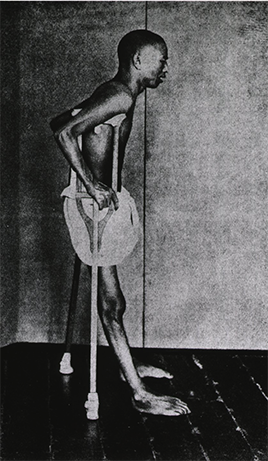
Beriberi was a common disease caused by lack of vitamin B1, or thiamine, which may be found in many types of beans, peas, lentils, barley, brown rice, and sunflower seeds, among other foods.
Scientists are finding new nutritional connections all the time, and physicians regularly tell patients to eat a healthy diet rich in various vitamins to maintain health and address or prevent various diseases. Mineral salts rich in iron are used for the treatment of iron deficiency, and potassium is used for electrolyte replacement therapy. These supplemental therapies are additional ways to help the body function naturally. Informed pharmacy staff can help consumers understand the role of vitamins.
 Put Down Roots
Put Down Roots
Hormone comes from the Greek word hormon, meaning “to set in motion” or “impel.”
Discoveries of Key Hormones and Hormonal Drug Therapies
Scientists in the early 1900s started to explore the effects of organ secretions on bodily functions. Hormones are the body’s secretions released by glands into the circulatory system that have specific regulatory effects on organs and other tissues. The last century brought new drug development in synthesized hormones, such as insulin, thyroid, and sex hormones, such as estrogen, progestin, and testosterone.
What if insulin and birth control medications were not available today? It is hard to comprehend the impact these discoveries have had not only on our health, but on our society. In the United States, it is estimated that more than 6 million patients with diabetes are staying alive and living normal lives while taking one or more types of insulin, much of it grown from cells in manufacturing laboratories. Today, over 100 million women worldwide use a form of oral contraception, colloquially referred to as “the pill”).
Insulin—A Lifesaver
Once, contracting diabetes, known as the “sugar disease,” was a terminal diagnosis. In the 1920s, research had shown a connection between problems with the pancreas and the disease of diabetes. The Canadian scientist, doctor, and Nobel Prize winner Sir Frederick Banting worked with his assistant Charles Best to try to isolate the pancreatic secretion that helps the body regulate sugar levels. They worked with diabetic dogs that were kept alive with an extract from the pancreas, which Banting and Best called isletin (named after the islets of Langerhans—pancreatic regions that secrete the hormone), simplified to insulin. In 1922, after insulin was isolated and purified, Banting and Best came to a hospital wing where comatose diabetic children were moving toward death. Their parents sat by their bedsides in tears or quiet sadness. As the two doctors moved through the room, injecting the patients, one by one the children started to awaken, and their families came alive, too, with joy. The effects of the insulin seemed miraculous, to say the least.
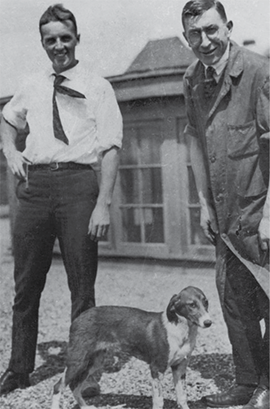
Charles H. Best (left) and Dr. Frederick Banting (right) in 1921 stand with a beagle that had been successfully treated with what would be called insulin.
 Practice Tip
Practice Tip
The educational materials on proper usage and potential side effects from the pharmaceutical manufacturer must always accompany the dispensing of birth control.
The Birth Control Pill
Another famous hormone drug is the oral contraceptive. Up until the mid-twentieth century, birth control was a taboo subject, and some state laws even prohibited teaching about contraceptive methods in medical schools. In the 1930s, the female sex hormones estrogen and progesterone and their functions were identified. Though funding was scarce and the hormones were difficult and expensive to develop, research continued in the hands of a few passionate scientists and activists. In 1960, the first birth control medication was approved by the FDA—Enovid—which had high doses of estrogen and progesterone. It worked but had dangerous and painful side effects. Levels were lowered, and combinations refined to safe levels. There are now many brands and generics available on the market, including emergency contraception (sometimes referred to as the “morning after” pill) that is available without a prescription. In the future, other birth control options may become available over the counter. However, they must be used with care, remembering that they do have side effects and may not fit an individual’s body chemistry. Side effects include but are not limited to nausea, thromboembolism (otherwise known as blood clots), cardiovascular disease, depression, and weight gain. Different types of hormonal contraception have different side-effect profiles.
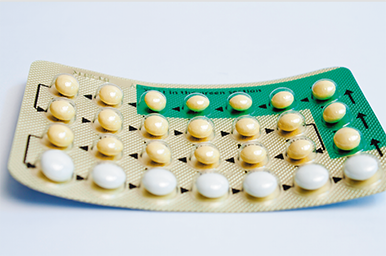
Oral contraceptives had a major effect on women’s reproductive choices and helped fuel women’s liberation in the 1960s.
Other Important Drug Discoveries
The last half of the twentieth century gave us many more significant medical and drug discoveries, especially in the areas of mental health, cancer chemotherapy, and gene therapy.
 Work Wise
Work Wise
Patients with mental health conditions sometimes feel stigmatized. They must be made to feel particularly welcomed and respected, so that they are willing to continue to take their medications.
Development of Drugs for Mental and Cognitive Health
Prior to the 1950s, mental distress and illnesses were treated in misguided and often painful or cruel ways, including punishment; imprisonment; ice-cold baths; induced vomiting, bleeding, comas, or seizures; physical or emotional isolation or restraint; brain surgeries to remove sections or make openings; and electric shock treatment. Chlorpromazine (Thorazine) was the first official US psychopharmaceutical drug used to treat mental health diseases, which was approved by the FDA for schizophrenia in 1954. Though it was effective, it wasn’t the magic bullet people had hoped for, as there were many dangerous side effects. It is seldom prescribed today, yet it opened the way for greater research into the effects of other drugs on the brain’s cognitive, emotional, and social functioning.
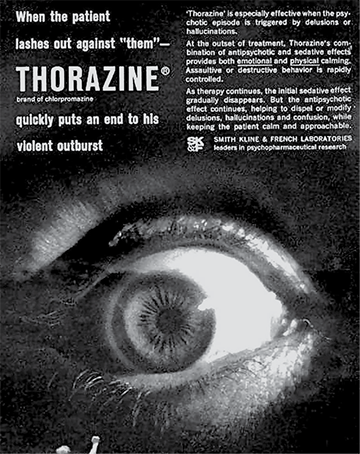
This is a 1962 ad for Thorazine (chlorpromazine), the first official US mental health drug.
Depression has long been a debilitating mental health disorder that can ruin lives and lead to suicide. In 1987, the FDA approved fluoxetine (Prozac) for treatment of depression. It provided major improvements over other medications as it could be taken once daily with fewer side effects. Because it could lift the spirits of people struggling painfully with depression, it became known as the “happy pill.” However, as with any drug, fluoxetine has its side effects and concerns. It is only one of many antidepressants, sleep aids, mood balancers, cognitive enhancers, and other mind-modulating drugs that are improving the lives of more than 54 million people worldwide struggling with mental illness.
 Practice Tip
Practice Tip
Beware: Adderall and Ritalin are commonly being over- or under-used, abused, or shared with those who do not have a legal prescription, especially by young people. It is important that patients do not take the effect of these drugs lightly and that they are directed to pharmacists for monitoring and counseling.
A common problem diagnosed in contemporary children is attention deficit hyperactivity disorder (ADHD). Drug therapies using amphetamine/dextroamphetamine (Adderall) and methylphenidate (Ritalin), which are mind-focusing stimulants, have helped these children increase their ability to pay attention, stay focused on activities, and control behavioral issues.
However, it must be remembered that most drugs used to treat ADHD are legal amphetamines. Amphetamine-like drugs are a group of Schedule II controlled substances that serve as stimulants to the central nervous system. Illegal amphetamines or amphetamine derivatives, such as methamphetamine, go by the street names speed, uppers, or crank. All amphetamines, whether prescribed or not, are habit forming and can cause dependence and addiction. Drugs used to treat ADHD can cause side effects, dependence, and addiction and must be used with caution.
Turning Poisons into Cancer-Fighting Treatments
In the 1900s, a cancer diagnosis meant a premature and painful death with almost no relief. Families could do little but support their loved ones and brace for the inevitable. However, hope came from an unexpected place: weapons of war.
In World War I, mustard gas burned the faces and skin of soldiers, and, in World War II, nuclear radiation bombs killed or caused radiation sickness and cancers in the Japanese citizens of Hiroshima and Nagasaki. During and after World War II, scientists and physicians began to experiment with these devastating substances in antineoplastic drugs, which use toxins to poison the cancer cells. Dysfunctional cancer cells grow much faster than normal cells, taking over a bodily organ or system. To do so, they absorb nutrients more quickly than other cells. But they also absorb toxins faster, which has the desired effect of killing the cancer cells. Unfortunately, the toxins also kill some of the normal cells and make someone sick, which is why there are intense side effects of hair loss, nausea, vomiting, and immune cell suppression.
Early chemotherapy treatments were a painful race for time. Which would happen first: would the treatment kill the cancer cells? Or would the side effects kill the patient, or would the cancer prevail and kill the patient? Remissions were common, but the cancer often won. However, as cancer drugs and radiation became more targeted and used along with antibiotics and other drugs that boosted the body’s immune system, survival rates became much higher. Now many children with leukemia often progress through childhood and go on to live healthy lives, and cancer survivors celebrate their freedom from the disease.
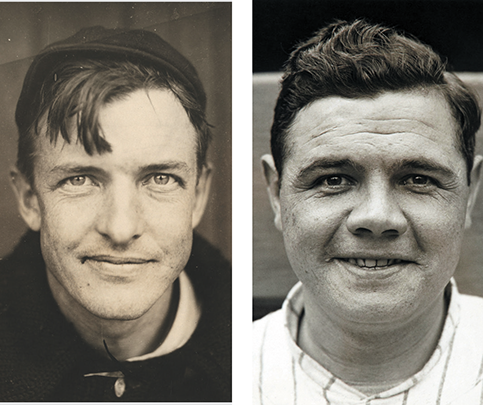
Famous Baseball Hall of Fame pitcher Christy Mathewson (left) died from exposure to mustard gas in World War I, and Babe Ruth (right) received cancer treatments that were made from nitrogen mustard, a similar compound, in the late 1940s.
Because these anticancer substances are so poisonous, technicians must be particularly careful in their dispensing, compounding, storage, and disposal. More will be discussed in Chapter 13 on hazardous compounding.
Unraveling Human Genetics
Much of our recent success in drug development is due to a better understanding of human genetics, or the biological codes in cells that determine an organism’s distinct inherited features. In 1953, the British physicist Francis Crick and American biologist James Watson were awarded a Nobel Prize for providing a model of the double-helix structure of the genetic strands of deoxyribonucleic acid (DNA). DNA is carried in the center of each cell and is made up of atomic matter that carries codes to direct the growth of the cell.
A gene is a distinct segment of DNA that determines a specific individual characteristic, such as blue eyes or brown hair. A defect in one’s DNA may increase the risk for developing certain diseases. Unraveling the DNA code and identifying the particular genes that affect specific diseases may make it easier to prevent or treat those diseases more effectively. Identifying a defective gene for a specific disease can assist in genetically designing a drug remedy for that disease, such as new forms of insulin for diabetes; clotting factors for hemophilia; potent anti-inflammatory drugs for rheumatoid arthritis; and drugs for combating viral and bacterial infections, anemia, and some cancers.
The development of genetically engineered drugs, drugs designed by manipulating genes in living substances to affect the genes in certain patient cells, has led to a new field of study that blends two scientific areas: pharmacology and genomics (or genetic molecular biology). Known as pharmacogenomics, it aims to design and produce drugs that cater to each individual’s genetic makeup.
For example, blood thinners are metabolized by patients at different rates, thus altering the pharmacological and toxic effects of the drugs. Genetic engineering could design a blood thinning drug personalized to the patient’s genes to produce the intended effects without the adverse reactions.
Biotechnology is the field of study that combines the sciences of biology, chemistry, and immunology to produce unique synthetic drugs with specific therapeutic effects. For cancer, new target-specific biotechnology drug treatments are making the difference between life and death, extending the quality of life without the debilitating side effects of earlier treatments. Research continues on personalized medications that tailor a drug, dose, and schedule to a specific disease in a specific patient. Because pharmacy technicians and pharmacists compound the correct ingredients and percentage for each patient, they are key links in the process of hope for cancer patients.
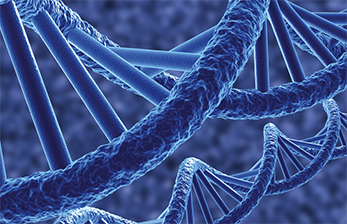
This computerized image of DNA shows the twisting ladderlike structure of genetic material. Scientists study the DNA’s chemical composition. Some new drugs swap deficient gene sections and proteins with effective ones.
Generic biotechnology drugs that function in similar ways as brand-name biologically engineered drugs are called biosimilars and interchangeables (biosimilars that can legally be substituted for the brand). Biogenetically engineered and biosimilar drugs can be manufactured from many original living sources, such as the cells of humans, animals, microorganisms, or yeasts.